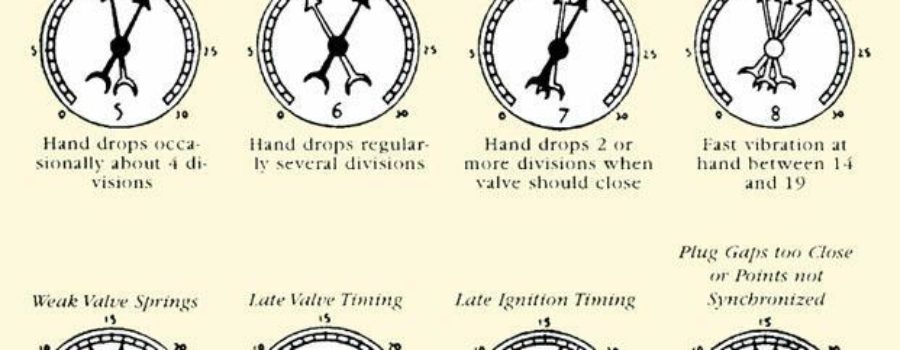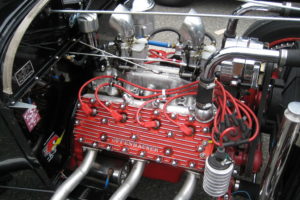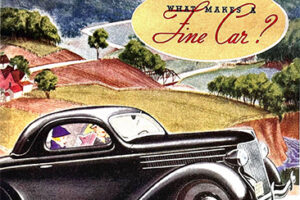The B.B. in the title represents that this is from the archive of the late Bill Bently, who ran a flathead Q&A informational site before he passed away. All threads from this source will be titled using the B.B. identifier on this site. We’re archiving some of the threads, so that his work is not lost or forgotten and so they will continue to educate flathead enthusiasts for years to come.
Irregardless of whether you have a pcv systems or not, …..I’d be tempted put a vacuum gauge on the engine and observe the readings during normal driving. An engine in good condition should read between 17 – 21 inches at idle with a steady needle. A vacuum gauge will help you figure out what the internals of the engine are like.

As far as blowby goes, the ‘after effects’ tend to be more noticeable when you pull up to the light as you have noticed.
Driving down the street at 40 mph a person will notice that the vacuum gauge will read a steady 5 or 10 inches as the engine is not working hard to idle the car along at that speed.. Putting your foot into it and accelerating and then maintaining 70 mph will cause the needle to drop to zero inches and beyond into (a) pressure.
When the needle drops to below zero (pressure), The engine starts pushing fumes and residue out thru any/all openings. This would tend to exaggerate the small amount of fumes that would normally be present as you pull up to a stop sign, Some of the fumes may be caused by the excessive residue burning off the hot engine and components just after working/running the engine in a positive or pressurized state.
The optimum engine operating rpm will be at the point were you are able to drive along while maintaining some sort of negative reading. Preferably 3 or 5 inches of vacuum – as a normal engines pcv systems will still have enough air movement to draw fumes/blowby out of the crankcase and direct it into the cylinders/combustion chambers were it is consumed in the charged cylinder.
…As you tend to work the engine harder and the vacuum drops to zero and then starts/creates a pressure, The ability of the pcv system is severely hampered in that the accumulative effects of blowby (fumes) are not drawn into the charged cylinders and accumulate inside the crankcase and engine.
When you pull up to a stop sign, These accumulated fumes are more noticeable as they waft out of the engine.
On a tired engine or one with no pcv system, there is little you can do about excessive blowby/smoke when you pull up to the stop sign….Other than, be aware of your driving habits and use the vacuum gauge as your guide in as to how far you push the gas pedal while cruising along,… Allowing the engine to work with somewhat of a negative reading on the gauge will aide in moving the accumulative fumes thru the pcv system and into the cylinders to be burnt off with the charged air/fuel mixture. Driving/cruising with a heavier foot will cause the engine to become pressurized and the fumes will accumulate in your engine and be far more noticeable at the stop lights.
Excessive blow-by is usually a good indicator that your cylinder walls and/or rings are worn.
Glazed cylinder walls will allow increasingly larger amounts of gases to slip out of the pressurized cylinder, past the rings thus creating more blowby. Worn rings will do the same.
A person can take some of the glazing off of the cylinder walls without tearing the engine apart… changing the oil to a non-detergent oil, and running the engine on it for a couple hundred miles, can have the effect of taking some of the glaze off the cylinder walls which aides in creating a better seal with the piston rings etc…
Just my two cents worth… Moe
From: Rumbleseat4 Sent: 3/17/2007 3:26 PM
Another old trick for removing the glaze from cylinders and to
seat new rings that refuse to seat (such as Chrome rings etc.):
Get the engine warm. Pull the plugs and dump in slighly less than 1/2 teaspoon of Bon-Ami scouring powder into each plug hole. Install plugs and start engine. Let it idle for about a minute and then drive it 35-45 mph for 25 miles without shutting it off. Immediately drain the oil and change it along with the oil filter (if you using one).
This is a very effective way to seat rings and remove glaze and was often used in the old days. Story: Ron, who builds the miniature engines, couldn’t get the rings to seat on the little Offy you’ve seen and heard run on this and the Ford barn site. He was about to pull it down and re-ring it when he was told to try the old Bon-Ami trick. Tried it. Stopped burning oil instantly.
It’s worth a try. ….rumble seat
Was this article a help? Consider supporting the Flat-Spot by becoming a Premium Member. Members get discounts with well known retailers, a cool membership packet full of goodies and your membership goes toward helping us upkeep and expand on this great archive.











